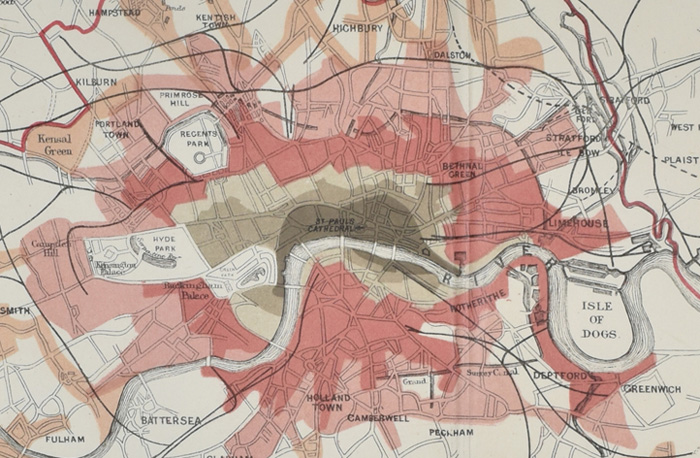Water Monopoly
 |
| Map showing the growth of London from 1560-1869, from the 'Royal Commission on Water Supply, Report of the Commissioners' (1869). GSL Library collection. The dark brown area shows London in 1560, the mid brown in 1745 and the light brown in 1818. The red indicates the growth of the city up until 1834, the pink until 1867. The areas marked in peach are suburbs. |
Prior to the establishment of the single Metropolitan Water Board in 1903, the supply of water to London was controlled by a monopoly of private water companies whose existence were established by Acts of Parliament.
The Statutory Water Companies
New River Company
Incorporated in 1619, London’s oldest water company was formed by the goldsmith Hugh Myddelton (1560-1631) as a result of a Parliamentary Act of 1606 to bring in “a freshe Streame of runninge Water to be brought to the North partes of the Cittie of London from the springs of Chadwell and Amwell and other springs in the Countie of Hertf(ord) not farr distance from the same, either in an open cut, or in close Truncke vaulte of brick or stone…” [Dickinson (1954) p34].
East London Waterworks Company
Founded in 1807, as part of its establishing bill it was authorised to purchase the Shadwell Waterworks (est c.1669) and West Ham Waterworks (est c.1747) which had previously supplied the East End of London. The original intake was the River Lea at Old Ford in Bow but deteriorating water quality saw them moving their intake higher up the river in 1829. The Old Ford site was still in use but poor management saw it becoming one of the main sources of the cholera outbreak of 1866.
Chelsea Waterworks Company
Established in 1723 to supply Westminster and the adjacent areas, the supply was originally taken from the Thames at Chelsea and stored in low canals around the site of the present Victoria Station. In 1725 two ponds in Green Park were converted into reservoirs and a third was constructed in Hyde Park. A series of small canals connected these reservoirs to the north of Victoria Station and then to the Thames at Chelsea. The company is notable for introducing the first filtration process in 1829, but by 1856 the water had become so polluted the intake was moved to Seething Wells, Surbiton. In 1877 the intake was moved to Molesley.
West Middlesex Waterworks Company
Established to meet the demand following the rapid expansion of London westwards beyond Kensington, the West Middlesex Waterworks Company was incorporated in 1806. Originally the intake was to be constructed at Poole’s Creek in Fulham but was instead moved to the Thames at Hammersmith. Following the Metropolis Water Act of 1852, the intake was moved to a site near Hampton village.
Grand Junction Waterworks Company
Established in 1811 as an offshoot of the Grand Junction Canal Company, the original intake was from via the Canal itself which was fed from the Brent and Colne rivers. However the poor water quality saw the source moved to the present site of Chelsea Bridge in 1820. The quality cannot have been much improved as it was directly opposite the outlet for the Ranelagh sewer/Westbourne Brook. A new intake was constructed at Brentford in 1835, moving to Hampton in 1855 to comply with the Metropolis Water Act of 1852.
Lambeth Waterworks Company
Incorporated in 1785 to supply Lambeth and the nearby areas. The original source of supply was on the south side of the Thames near to the current site of the Royal Festival Hall. In 1848 a Parliamentary Bill was passed to move the intake further up the Thames as the water quality at the old site was so poor. In 1852 the new site opened at Surbiton but periodic floods from the River Mole saw the Company moving their intake site to West Molesey in 1872.
Southwark and Vauxhall Waterworks Company
 |
|
Prospectus for the Metropolitan Anti-Water-Monopoly Association, [1849]. Tracts: Prestwich P/1 |
The original source of supply for the South London Waterworks was from the Effra River which flowed into the Thames at Vauxhall Creek but it had silted up and become polluted by the time it was abandoned in 1832. After this, water was drawn from the Thames at Vauxhall.
The Southwark Water Company originally drew its water from the Thames at London Bridge.
In 1845, near the site of the old Battersea Power Station, a new works (and source) was constructed and in 1855 another intake at Hampton was introduced.
Hampstead Waterworks Company
Incorporated in 1692, it supplied water from the ponds at Highgate and Hampstead. In 1833 a chalk well sunk at the lower end of Hampstead Heath added to the supply. The company was taken over by the New River Company in 1856.
Kent Waterworks Company
Founded in 1809, the original intake source was from the Ravensbourne –as the company was forced to purchase the Ravensbourne Waterworks (est 1701) to get its establishing bill through Parliament.
By 1857, increase in demand as well as the deteriorating water quality led to a number of chalk wells being sunk between Deptford and Charlton. The Ravensbourne was discarded as a source by 1861.
Plumstead, Woolwich and Charlton Consumers’ Pure Water Company
This short-lived company which is shown in the above map, was established in 1852 with the intention of supplying water using a patented water softening process. Despite sinking a well and constructing machinery it went bankrupt by 1858 and was officially wound up in 1860. It was bought out by the Kent Waterworks Company.

